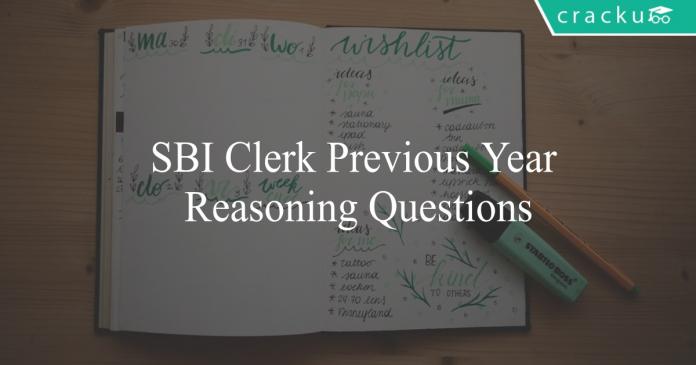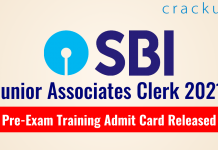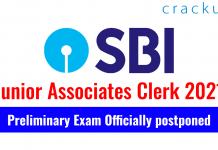SBI Clerk Previous Year Reasoning Questions
Download SBI Clerk Reasoning Previous Year Questions & Answers PDF for SBI Clerk Prelims and Mains exam. Very Important SBI Clerk Reasoning Previous Year questions on with solutions.
Download SBI Clerk Previous Year Reasoning Questions
790+ Mocks – Just Rs. 194. Use coupon: SBIDREAM70
Question 1: In the following question, select the related letters from the given alternatives.
GAFT : PJOC :: WORS : ?
a) FXBA
b) FAXB
c) FXAB
d) FXJB
Question 2: Find the option that should replace the (?) so that the second pair bears the same relationship as the first pair:
84:48::73: ?
a) 56
b) 16
c) 40
d) 36
e) 46
Instructions
Study the following information and answer the questions given below.
If,
A # B means A is father of B
A & B means A is husband of B
A @ B means A is sister of B
A % B means A is daughter of B
Question 3: Which of the following should replace question mark (?) such that P is son-in-law of T?
P & Q (?) R & S @ T
a) %
b) @
c) &
d) #
e) Either A or B
Download SBI Clerk Previous Papers PDF
Take a free mock test for SBI Clerk
Question 4: Which of the following shows that E is sister-in-law of A?
a) A & B @ C % F @ D & E
b) A @ B & C % D @ E & F
c) A & B % C # D @ E % F
d) More than one of the options above
e) None of these
Instructions
Choose which of the conclusion(s) follow(s) based on the statements given:
Question 5: $ E \geq D$; $ A = C$; $ A > B$; $ F = E$; $ B < D$;
Conclusions:
I: $ E > A$
II: $ F \leq C$
a) Only conclusion I is true.
b) Only conclusion II is true.
c) Either conclusion I or conclusion II is true.
d) Both the conclusions are true.
e) Neither of the conclusions is true.
Question 6: $ R = S$; $Q \geq P$; $S < T$; $ T > Q$;
Conclusions:
I: $ T \geq P$
II: $ R \leq Q$
a) Only conclusion I is true.
b) Only conclusion II is true.
c) Either conclusion I or conclusion II is true.
d) Both the conclusions are true.
e) Neither of the conclusions is true.
Instructions
Directions: Triangle($\blacktriangle$) represents 1 and Circle($\circ$) represents 0. If triangle appears in unit’s place, then its value is 1. If it appears in ten’s place, then its value is doubled to 2 and so on.
For example:
$\blacktriangle$ = 1
$\blacktriangle \circ \blacktriangle \blacktriangle$ = 8+0+2+1 = 11
$\circ \blacktriangle \blacktriangle$ = 0+2+1 = 3
Question 7: What will be the code for 18 in this language?
a) $\blacktriangle\circ\circ\circ\blacktriangle$
b) $\blacktriangle\circ\circ\blacktriangle\circ$
c) $\blacktriangle\circ\blacktriangle\circ\blacktriangle$
d) $\blacktriangle\circ\blacktriangle\circ\circ$
e) None of these
Banking Study Material – 18000 Questions
Question 8: What is the value of $\blacktriangle \blacktriangle\blacktriangle\circ$?
a) 13
b) 12
c) 11
d) 14
e) None of these
Instructions
Study the following information and answer the questions given below.
Sam started from his home towards his office. He walked 12 metres towards South and turned left at point A. He then walked 35 metres and turned right at point B. Then he walked 16 metres and turned left at point C. Finally he walked 10 metres and stopped at his office.
Question 9: Find the shortest distance between his home and his office?
a) $54\sqrt{3}$ metres
b) $53$ metres
c) $51\sqrt{2}$ metres
d) $47$ metres
e) None of these
Question 10: Find the shortest distance between his home and point B?
a) $34\sqrt{3}$ metres
b) $37$ metres
c) $31$ metres
d) $47\sqrt{2}$ metres
e) None of these
Question 11: 40
a) Figure 1
b) Figure 2
c) Figure 3
d) Figure 4
e) Figure 5
Question 12: 39
a) Figure 1
b) Figure 2
c) Figure 3
d) Figure 4
e) Figure 5
Instructions
Ten colleagues named A,B,C,D,E,F,G,H,I,J are sitting on two linear rows of chairs, both facing each other. They all belong to Mumbai, Patna, New Delhi, Bangalore, Hyderabad, Chandigarh, Jaipur, Kolkata, Chennai, Guwahati (not in that order). Each person is facing someone else. The cities New Delhi, Mumbai, Chennai and Kolkata are called metros. It is also known that :
Only one person from the metros sits in the corner. Only one pair of people facing each other are from metros. H from Kolkata faces C from New Delhi. A and B sit in the corner in the same row. The person from Bangalore is the immediate neighbour of the person from New Delhi and the person from Chennai. A from Mumbai and the person from Kolkata sit next to each other. I faces the person from Hyderabad. D has both the neighbours from a metro.The people from Chandigarh and Jaipur sit on corners in the same side. J sits immediately to the right of the person facing the person second to the right of I. The person from Guwahati does not sit in the corner. The person from New Delhi sits second to the right of the person facing E.
Question 13: If I and G sit next to each other, who sits opposite to the person from Mumbai ?
a) G
b) H
c) F
d) A
e) E
Question 14: People from which group of cities are sitting in the corner ?
a) Jaipur, Chandigarh, Guwahati, Hyderabad
b) Jaipur, Chandigarh, Mumbai, Patna
c) Guwahati, Jaipur, Bangalore, Patna
d) Chandigarh, New Delhi, Mumbai, Chennai
e) Cannot be determined
Instructions
Find the missing number (?) in the given series from the options provided.
Question 15: 2, 4, 7, 11, 16, ?
a) 22
b) 21
c) 20
d) 23
e) 24
Question 16: 9, 27, 45, 63, ?
a) 79
b) 80
c) 81
d) 82
e) 83
Instructions
Digvijay, Gayatri, Falguni, Mahima, Tanya, Sachin, Lalit and Abhinav are lawyers who attend an interview. One interview is held on each day of the week from Monday to Saturday and two interviews are held on Sunday. The interviewer asks questions on any one of the subjects among company law, the Indian penal code, the Indian bankruptcy code, administrative law, constitutional law, jurisprudence, land laws and family law. Also, among the candidates’ two wear blazers, two wear ties, two carry files and two wear moccasins, each candidate has at least one of the above.
Additional information which has been given:
1. Digvijay who is interviewed on a Wednesday does not wear a blazer. Administrative law is asked on a Saturday.
2. The interviewer tries to schedule interviews such that the first letter of the day is the same as the candidates’ initials.
3. The ones who carry files are either asked questions on land laws or on company law and are interviewed before Thursday.
4. The ones who wear blazers are interviewed on consecutive days which is not over the weekend.
5. If Mahima is asked questions on land laws then Abhinav will be asked on family law and vice-versa. There must be at least one day in between Mahima and Gayatri’s interview.
6. Gayatri does not know about the Indian bankruptcy code so she fails the interview.
7. Sachin and Abhinav wear moccasins while Lalit’s interview is the last and he is asked about Jurisprudence.
8. The one interviewed on Wednesday wears the same attire as what one of the candidates wears on Sunday.
Question 17: Which of the following is a correct triplet?
a) Falguni-Constitutional law-Blazer
b) Digvijay-Wednesday-Tie
c) Lalit-Jurisprudence-Moccasins
d) More than one of the above
e) None of the above
Question 18: Which of the following subjects is asked on the weekend?
a) Constitutional law
b) Land Laws
c) Company Law
d) None of the above
e) More than one of the above
Instructions
In the following question three statements are given, followed by two conclusions. You have to consider the statements to be true even if they seem to be at variance from commonly known facts. You have to decide which of the given conclusions, if any, follows from the given statements and select the appropriate option.
Question 19: Statement I: All crows are black
Statement II: Some pigeons are black
Statement III: Some pigeons are bats
Conclusion I: All crows can be pigeons
Conclusion II: All bats can be black
a) Conclusion I only
b) Conclusion II only
c) Both the conclusions follow
d) Either conclusion I or conclusion II follows
e) None of the conclusions follows
Question 20: Statement I: All batsmen are wicket keepers
Statement II: No wicket keeper is a bowler
Statement III: All bowlers are all rounders
Conclusion I: All batsmen being all rounders is not a possibility
Conclusion II: No wicket keeper is an all rounder
a) Conclusion I only
b) Conclusion II only
c) Both the conclusions follow
d) Either conclusion I or conclusion II follows
e) None of the conclusions follows
General Knowledge Questions & Answers PDF
Answers & Solutions:
1) Answer (C)
The logic followed here is (n + 9). Hence, the code for GAFT will be,
G + 9 = P, A + 9 =J, F + 9 = O, T + 9 = C.
Similarly, the code for WORS is,
W + 9 = F, O + 9 = X, R + 9 = A, S + 9 = B.
Hence, option C is the correct answer.
2) Answer (C)
$84 = 8^2 – 4^2 = 64 – 16 = 48$
Using the same logic,
$73 = 7^2 – 3^2 = 49 – 9 = 40$.
Therefore, option C is the right answer.
3) Answer (A)
By putting % in the blank,
P & Q → P is husband of Q
Q % R → Q is daughter of R
R & S → R is husband of S
S @ T → s is sister of T.
Here, P is husband of Q who is niece of T.
Hence, P is son-in-law of T.
4) Answer (C)
By checking Option C,
A & B → A is husband of B
B % C → B is daughter of C
C # D → C is father of D
D @ E → D is sister of E
E % F → E is daughter of F
Here, E is sister of B who is A’s wife.
Hence, E is sister-in-law of A.
5) Answer (C)
The given statements can be combined and expressed as $ C = A > B < D \leq E = F$.
$F \leq C$ can be written as $ A \geq E$.
The 2 conclusions, state that $ A < E $ or $ A \geq C$.
One among these 2 conclusions must definitely follow.
Therefore, either conclusion I or conclusion II follows. Therefore, option C is the right answer.
6) Answer (E)
The given statements can be combined as $R = S < T > Q \geq P$.
$T$ is greater than $Q$. Therefore, $T$ is definitely greater than $P$. Conclusion I is false since it states that $T \geq P$.
No relationship can be established between $R$ and $Q$ since there is a change in the sign of the inequality. Therefore, conclusion II does not follow.
Neither of the conclusions follow. Therefore, option E is the right answer.
7) Answer (B)
18 can be written as 16+0+0+2+0 = $\blacktriangle\circ\circ\blacktriangle\circ$
8) Answer (D)
$\blacktriangle \blacktriangle\blacktriangle\circ$ = 8+4+2+0 = 14
9) Answer (B)
The below diagram can be drawn using given statements.

Shortest distance between his home and his office $= \sqrt{28^2 + 45^2} = \sqrt{784+2025} = \sqrt{2809} = 53$ metres
10) Answer (B)
The below diagram can be drawn using given statements.

Shortest distance between his home and his office $= \sqrt{12^2 + 35^2} = \sqrt{144+1225} = \sqrt{1369} = 37$ metres
11) Answer (A)
12) Answer (A)
13) Answer (C)
We know that H from Kolkata faces C from New Delhi. We also know that since only pair of people from the metros face each other, there is no other pair of people looking at each other who are both from metros.
We also know A and B sit on the corners of the same row and we see that A sits next to the person from Kolkata ie H.
Thus, the arrangement will look like this :
We have assumed that the person on the top row faces down and the person from the bottom row faces up.

The person from Bangalore is the immediate neighbour of the person from New Delhi and the person from Chennai. We know that C is from New Delhi, so it means that the person from Bangalore sits between the person from New Delhi ie H and the person from Chennai. Now the arrangement will look like this :

D has both the neighbours from a metro, which is possible only if D is the person from Bangalore. Since the people from Jaipur and Chandigarh sit on corners, we know that they will be the ones on the corners of the top row. The person from New Delhi sits second to the right of the person facing E which means that E will be facing the person who is second to the left of C ie the person from New Delhi. Now the arrangement will look like this :

J sits immediately to the right of the person facing the person second to the right of I. This condition means that I can be in two places : facing D or facing E. We know that I faces the person from Hyderabad and since D is from New Delhi, we can say that I faces E who is from Hyderabad. We also know that the person from Guwahati is not sitting at the corners, ie he/she is facing D. Therefore, we can say that B is from Patna (only city left). Now the arrangement will look like this :

Since we know the names of the two people left, we can further say that :

From the figure, we can see that if G sits next to I then F will sit opposite A who is from Mumbai.
14) Answer (B)
We know that H from Kolkata faces C from New Delhi. We also know that since only pair of people from the metros face each other, there is no other pair of people looking at each other who are both from metros.
We also know A and B sit on the corners of the same row and we see that A sits next to the person from Kolkata ie H.
Thus, the arrangement will look like this :
We have assumed that the person on the top row faces down and the person from the bottom row faces up.

The person from Bangalore is the immediate neighbour of the person from New Delhi and the person from Chennai. We know that C is from New Delhi, so it means that the person from Bangalore sits between the person from New Delhi ie H and the person from Chennai. Now the arrangement will look like this :

D has both the neighbours from a metro, which is possible only if D is the person from Bangalore. Since the people from Jaipur and Chandigarh sit on corners, we know that they will be the ones on the corners of the top row. The person from New Delhi sits second to the right of the person facing E which means that E will be facing the person who is second to the left of C ie the person from New Delhi. Now the arrangement will look like this :

J sits immediately to the right of the person facing the person second to the right of I. This condition means that I can be in two places : facing D or facing E. We know that I faces the person from Hyderabad and since D is from New Delhi, we can say that I faces E who is from Hyderabad. We also know that the person from Guwahati is not sitting at the corners, ie he/she is facing D. Therefore, we can say that B is from Patna (only city left). Now the arrangement will look like this :

Since we know the names of the two people left, we can further say that :

From the figure, we can see that the people from Option B are the ones sitting in the corner.
15) Answer (A)
$\Rightarrow$ $T_{2} – T _{1} = 4 – 2 = 2$
$\Rightarrow$ $T_{3} – T _{2} = 7 – 4 = 3$
$\Rightarrow$ $T_{4} – T _{3} = 11 – 7 = 4$
$\Rightarrow$ $T_{5} – T _{4} = 16 – 11 = 5$
Here we can see the pattern that difference between consecutive terms are in A.P. and it is increasing by 1. Therefore,
$\Rightarrow$ $T_{6} = 6 + T _{5} = 6+16 = 22$
Hence, option A is the correct answer.
16) Answer (C)
$\Rightarrow$ $T_{1} = 9 = 5^2 – 4^2$
$\Rightarrow$ $T_{2} = 27 = 6^2 – 3^2$
$\Rightarrow$ $T_{3} = 45 = 7^2 – 2^2$
$\Rightarrow$ $T_{4} = 63 = 8^2 – 1^2$
Hence, we can say that $\Rightarrow$ $T_{n} = (n+4)^2 – (5-n)^2$
$\Rightarrow$ $T_{5} = (5+4)^2 – (5-4)^2 = 81$
Hence, option C is the correct answer.
17) Answer (B)
From statement 1, 2, and 7 we can gather the following information:

Now, as per statement 2 Tanya will be interviewed either on Tuesday or Thursday and Sachin will be interviewed on either Saturday or Sunday.
If Tanya is interviewed on Thursday and Sachin is interviewed on Saturday then Gayatri must be interviewed on Sunday since statement 5 says at least a one day gap is required between Mahima and Gayatri’s interview. So, Abhinav will have to be interviewed on Tuesday. [Case 1]
Similarly, If Tanya is interviewed on Thursday and Sachin is interviewed on Sunday then Gayatri must be interviewed on Saturday since statement 5 says at least a one day gap is required between Mahima and Gayatri’s interview. However, Gayatri is asked questions on Indian Bankruptcy Code (IBC) (from statement 6) while the person interviewed on Saturday is asked admin law (statement 1) so this case is not possible.
If Tanya is interviewed on Tuesday and Sachin on Sunday then Gayatri will have to be interviewed on Thursday since she is asked about IBC and not admin law.
From statement 4 we know that the ones wearing blazers must be on consecutive days apart from the weekend. Also, Digivijay does not wear a blazer (statement 1) so the ones wearing a blazer can either be on Monday and Tuesday or Thursday and Friday. From statement 3 we know that the ones carrying files are interviewed before Thursday, so on any two of the days among Monday, Tuesday and Wednesday.
Even if one of the days is Wednesday, at least one person must carry a file on Monday and Tuesday. So, the ones wearing a blazer must be on Thursday and Friday.
In Case 1, upon placing the information we get the following:

However, as per statement 8, this is not possible. So, this case can be eliminated.
Similarly we can eliminate other cases. The only possible way, all the conditions are followed is:

So, Option B is correct.
18) Answer (D)
From statement 1, 2, and 7 we can gather the following information:

Now, as per statement 2 Tanya will be interviewed either on Tuesday or Thursday and Sachin will be interviewed on either Saturday or Sunday.
If Tanya is interviewed on Thursday and Sachin is interviewed on Saturday then Gayatri must be interviewed on Sunday since statement 5 says at least a one day gap is required between Mahima and Gayatri’s interview. So, Abhinav will have to be interviewed on Tuesday. [Case 1]
Similarly, If Tanya is interviewed on Thursday and Sachin is interviewed on Sunday then Gayatri must be interviewed on Saturday since statement 5 says at least a one day gap is required between Mahima and Gayatri’s interview. However, Gayatri is asked questions on Indian Bankruptcy Code (IBC) (from statement 6) while the person interviewed on Saturday is asked admin law (statement 1) so this case is not possible.
If Tanya is interviewed on Tuesday and Sachin on Sunday then Gayatri will have to be interviewed on Thursday since she is asked about IBC and not admin law.
From statement 4 we know that the ones wearing blazers must be on consecutive days apart from the weekend. Also, Digivijay does not wear a blazer (statement 1) so the ones wearing a blazer can either be on Monday and Tuesday or Thursday and Friday. From statement 3 we know that the ones carrying files are interviewed before Thursday, so on any two of the days among Monday, Tuesday and Wednesday.
Even if one of the days is Wednesday, at least one person must carry a file on Monday and Tuesday. So, the ones wearing a blazer must be on Thursday and Friday.
In Case 1, upon placing the information we get the following:

However, as per statement 8, this is not possible. So, this case can be eliminated.
Similarly we can eliminate other cases. The only possible way, all the conditions are followed is:

Option D is correct.
19) Answer (C)

From the diagram, we can see that All crows can be pigeons and All bats can be black.
Hence, option C is the correct answer.
20) Answer (E)

From the diagram, we can see that all batsmen being all rounder is a possibility and some wicket keepers can be all rounders.
Hence, option E is the correct answer.
We hope this Reasoning Question & Answers PDF of SBI Clerk is very Useful for preparation of SBI Clerk Exams.





